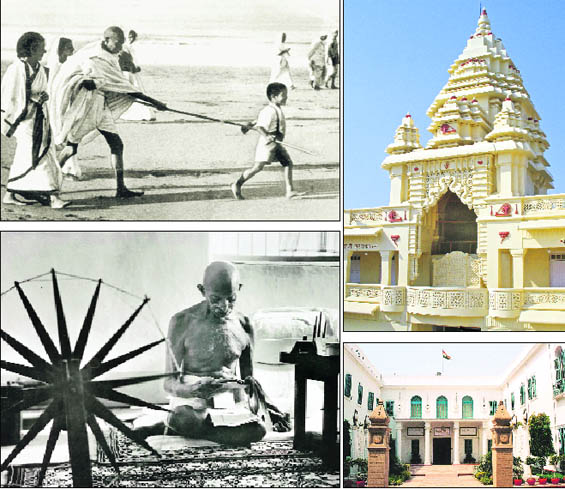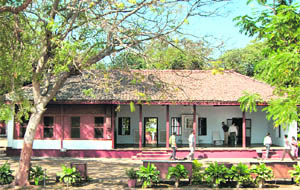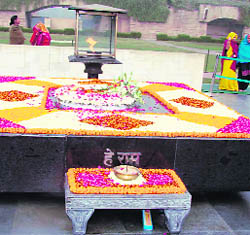|
Footprints of The
Mahatma
From the seaside
port of Porbandar in Gujarat — where Mohandas Karamchand
Gandhi was born — to the serene environs of Raj Ghat in Delhi,
where he found his final resting place, Vimla
Patil trails Bapu’s journey into independent India’s
history
Kirti Mandir,
Bapu’s birthplace
At
the
paisley-shaped tip of Saurashtra in Gujarat, lies the quiet town
of Porbandar, the birthplace of Mohandas Karamchand Gandhi, one
of the greatest icons of the 20th century. Little did his
parents know at the birth of their son Mohan, that one day he
would illuminate the souls of countless people all over the
world and leave footprints in the pages of India’s history.

Clockwise from top left: The Mahatma found unique ways to gather a huge number of people around him; Kirti
Mandir, Porbandar, Gujarat, the birthplace of Bapu; Birla House, Gandhi
Smriti, New Delhi, where Gandhiji spent his last months; and the charkha had become the symbol of his struggle for Swadeshi goods and his simple lifestyle |
Known for its
pristine beaches and quiet courtyards, Porbandar is today a
pilgrimage centre for Gandhiji’s followers. It is said that
the Gandhi family purchased their residence in this seaside town
because Karamchand, Gandhiji’s father and earlier Uttamchand,
his grandfather, were both Diwans of the Raja of Porbandar, a
flourishing trade port and fishing town. Mohandas was born on
October 2, 1869, in this house. Gandhiji’s family
continued to live in this house until it was converted into a
museum of the memorabilia of the leader after India’s
Independence. What is also interesting is that the home of
Kasturba, Gandhiji’s teenager wife, also stands right behind
the Gandhi residence in Porbandar. Called Gandhi because of
their trade in fragrances, the family of Mohanchand was friendly
with the parents of Kastur and, thus, arranged the marriage of
the two when they were both barely 13.
The Gandhi
family moved to Rajkot after Karamchand fell out with the Raja
of Porbandar and took the position of the Diwan of Rajkot where
Mohandas went to the Alfred High School. Not doing so well in
his studies, Mohandas was sent to England to study law at an
early age and returned with a law degree to India.
Today, both the
birthplace of the Mahatma in Porbandar and the school he
attended in Rajkot are museums with memories of the Father of
the Nation ensconced in every object. From his pocket watch to
diaries, books to his baithak of khadi, his personal
possessions to his walking stick. The Porbandar house is called
Kirti Mandir and offers a photo exhibition, which unfolds the
story of Mahatma Gandhi’s life with all-important events,
which marked his battle for truth and the support that Kasturba
gave him through every phase of his life.
Kochrab Harijan
Ashram, Ahmedabad
Soon after
completing his education in England, Gandhiji briefly returned
to India and then went to South Africa, accepting a job to start
his career. This is where he first came across injustice against
the Indian population by the white rulers and started his
opposition with the help of his compatriots. His biographers
agree that South Africa was the place where the flame of social
commitment was lit in Mahatma’s heart. It was here, seeing the
suffering of the coloured people, including poor Indian workers
and labourers, that he decided to devote his life to the service
of the underprivileged and to his fight against injustice and
oppression.
Gandhiji
returned to India in 1914 and was immediately involved in India’s
struggle for freedom. The first institution he established at
this time was Kocharab Harijan Ashram, Ahmedabad. However, he
had to abandon the project after facing opposition for accepting
a family of untouchables into the ashram. This ashram stands now
in the heart of Ahmedabad on the opposite bank of the river from
the Sabarmati Ashram, which was later founded by him.
Sabarmati
Ashram, Ahmedabad

Mahatma Gandhi's house at Sabarmati Ashram in Ahmedabad and
(below) Raj Ghat, Bapu’s final resting place on the banks of the Yamuna in New Delhi |
When opposed by
his own community, Gandhiji founded this commune-like residence
in 1919 on the banks of the Sabarmati river. And until he
launched his Dandi Salt March in 1930, this remained his home
where he returned after every ‘expedition’ to fight
injustice, oppression and slavery in various states of India,
including Bihar, Bengal, Maharashtra, Gujarat and others, using
his weapons of Satyagraha and non-violent protests. Describing
his efforts, Gandhiji’s biographer Louis Fischer has said,
"His greatness lay in doing what everyone could do but
doesn’t."
Gandhiji found
unique ways to gather huge number of people around him and to
give a tremendous energy to the freedom struggle with causes
that he sometimes won and sometimes lost. But losing a cause
never meant giving up – Gandhiji relentlessly pursued his goal
of India’s Independence and the dignity of its millions.
 By the time he
was a resident of Sabarmati Ashram, Gandhiji already wore only khadi
and only a brief dhoti and a shawl-like cover for his
frail shoulders. The charkha had become the symbol of his
struggle for Swadeshi goods and his simple lifestyle identified
him as the true leader of the masses. A great story is narrated
about the high point of Gandhiji’s opposition to the British
rule in India. When he was invited to meet King George V during
the Round Table Conference in 1931, Winston Churchill described
him as ‘the naked fakir’. Gandhiji refused to ‘dress up’
to appear in the king’s presence as per the court protocol and
the king had to see him as he was – a representative of the
people of India, oppressed by a colonial power. By the time he
was a resident of Sabarmati Ashram, Gandhiji already wore only khadi
and only a brief dhoti and a shawl-like cover for his
frail shoulders. The charkha had become the symbol of his
struggle for Swadeshi goods and his simple lifestyle identified
him as the true leader of the masses. A great story is narrated
about the high point of Gandhiji’s opposition to the British
rule in India. When he was invited to meet King George V during
the Round Table Conference in 1931, Winston Churchill described
him as ‘the naked fakir’. Gandhiji refused to ‘dress up’
to appear in the king’s presence as per the court protocol and
the king had to see him as he was – a representative of the
people of India, oppressed by a colonial power.
Sabarmati
Ashram was also the starting point of Gandhiji’s famous Salt
March to Dandi in 1930 to oppose British atrocities on Indians.
A symbol of India’s non-violent strength, the Dandi March for
Salt Satyagraha became a watershed event in the freedom for
struggle, despite its failure to revoke unjust laws because it
drew thousands of people into the freedom struggle. But it was
also the event that put an end to Gandhiji’s stay in the
ashram.
Gandhi Barrack
and Aga Khan Palace, Pune
Now a famous
monument, this jail in Pune had the honour of being ‘home’
to Gandhiji twice during his fight for the Independence. The
room where he was imprisoned and the courtyard in front of the
room are now named Gandhi Barrack and are considered a Gandhi
Memorial.
Other leaders
who shared this jail with Gandhiji were Jawaharlal Nehru and
Sardar Vallabhbhai Patel. In Pune, also stands Aga Khan Palace,
where Gandhiji and Kasturba were detained by the British. This
is where Gandhiji suffered ill health due to malaria and lost
Kasturba, his companion and wife of 62 years in 1944. Gandhiji’s
close aide, Mahadev Desai, also died in this palace. Gandhiji
built the samadhis of both these important people in his
life with his own hands with mud and stones. Later, the samadhis
were covered with marble and the palace is today a Gandhi
monument.
Sevagram, Wardha,
Maharashtra
After the Salt
March failed to persuade the British to change oppressive laws
against poor Indians, Gandhiji vowed that he would not return to
Sabarmati Ashram till Independence came eventually in 1947.
After his return from the Round Table Conference in 1931, he
founded Sevagram Ashram at Shegaon, near Wardha, in Vidarbha,
Maharashtra. Many events of the fight for freedom were launched
from here. Today, Sevagram is a cluster of communes and ashrams
that have been designated as a monument.
Birla House,
Gandhi Smriti, New Delhi
Gandhiji often
stayed at the various homes of the famous industrial family of
the Birlas and they in their turn, followed Gandhi by
contributing to his programmes and supporting the cause of
Independence. The Birla residence in New Delhi was the place
where Gandhiji spent the last months of his life. He returned to
New Delhi from Kolkata in December 1947 because his usual
residence in the Sweepers’ Colony was overrun by shanties for
refugees. At Birla House, he undertook his last fast for
communal harmony and peace. On the evening of January 20, 1948,
an attempt on his life failed when a crude bomb exploded behind
him and left him unhurt.
Ten days later,
the same assassins who had made the earlier effort to kill him,
gathered at the prayer meeting on January 30, 1948, and Nathuram
Godse, one among them, barred his way and fired four bullets at
him at around 5.17 p.m. Gandhiji died almost instantly, being
hit by three of the bullets. He collapsed, never to rise again.
Birla House is
today a national monument to the memory of Gandhiji and is
visited by lakhs of followers and admirers. The spot, where he
was assassinated, is marked by a stone tablet and his room is
preserved as it was when he lived therein. The monument also has
a photographic exhibition of events from Bapu’s life.
Gandhi Memorial,
Raj Ghat, New Delhi
Gandhiji’s
last journey — an event attended by a million grieving Indians
— took him to the banks of the Yamuna in New Delhi. Here, in
the verdant gardens on the riverbank, the Father of the Nation
was cremated with full national honours on January 31, 1948.
Today, an eternal flame burns at the site, reminding the world
of the selfless man who gave his life for peace and harmony in
the world and equality for all human beings.
Opposite the final resting
place of Gandhiji, stands Gandhi Museum. It houses a photo
gallery depicting Gandhiji’s various homes and a collection of
reference books. On show are the clothes, which Gandhiji wore at
the time of his assassination, his possessions and the gun that
killed him as well as the urns that held his ashes before the
ashes were immersed into the Ganga. There is a replica of the
train that carried the ashes to Prayag for immersion. The nearby
Gandhi Darshan complex also houses an exhibition of photographs
describing the life of Mahatma Gandhi and the non-violent
movement, which he spearheaded.

|